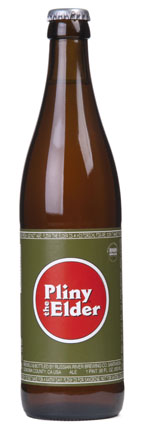Top Tastings 2012
ABV: 8%
Origin: Santa Rosa, California, USA
Website: www.russianriverbrewing.com
Russian River brewer Vinnie Cilurzo is generally credited with creating the Double IPA as a commercial beer style. Inaugural IPA, the first beer Vinnie brewed professionally, was so named as it launched his first brewing venture, Blind Pig at Temecula, California, in June 1994. But as it turns out, it also inaugurated a slew of ultra-hoppy West Coast pale ales that turned out to be arguably as influential internationally as the original British India Pale Ales had been in their day.
There were enough double IPAs around by 2001 for the Bistro restaurant in Hayward, California, to stage a whole festival dedicated to the style, involving 10 brewers. Vinnie had since moved to Russian River, and devised a new beer for the festival. It was named after Roman naturalist and naval commander Pliny the Elder, or Gaius Plinius Secundus, killed in the famous eruption of Vesuvius in 79 that also engulfied Pompeii. His book Naturalis Historia contains – possibly – the earliest known written mention of hops.
So Pliny the Elder isn’t itself the first Double IPA, but it certainly has an authentic pedigree. It’s also become one of the most celebrated beers in the style, regularly figuring in the upper reaches of Top 10 lists and winning several awards.
As I’ve described elsewhere, Pliny was my first taste of US craft beer on US soil when I sampled it on cask at the Russian River brewpub in Santa Rosa in 2005. In retrospect it probably wasn’t the best introduction. Even many of its fans would agree it’s hardly the best gateway beer for a palate still unaccustomed to the flavour spectrum of West Coast pales. And I’ve since concluded that cask conditioning is not the format in which such brews best express themselves – they need the extra sparkle trapped in a bottle or keg to help them sing.
At the time I noted a slightly cloudy pale golden ale, with only a little white lace for a head and a sweet aroma of glycerine, jasmine and pineapple. A thick and furry palate had pineapple, geranium, pine, leather and sacky notes. A bitter swallow led to a long and massively intense pine, pepper and fruity hop finish that puckered like strong tea.
Since then I’ve drunk many more big, strong, hoppy pale ales from the US and elsewhere and my palate is better calibrated to their pleasures. But other than that first cask encounter I hadn’t yet returned to Pliny. I put that right in October 2012 by picking up a bottle at Best Damn Beer Shop in San Diego.
This time the golden colour was much more attractively set off with a rich white head. The aroma was still thick and strong – I noted peach, fresh flowers, citrus and gunpowder. A resinous, tannic and vividly hoppy palate had peach fruit striated with lemon balm, and emerging flavours of mint, pine, fresh grass and creamy malt.
A very long and slowly unfolding finish saw pine and tannins coming to the fore, offset by coating and creamy malt, with plenty of spice and a late fresh pepper note. Though describing the hop character of the beer as assertive seems something of an understatement, it remained perfectly composed, taking time to tell its long and complex story of flavour.
This is a beer that asks you to drink it fresh, displaying the date on the bottle, so I was glad to see mine was no more than a month old. Reconsidering it on a more flattering platform, I agree that it deserves its high reputation as one of the best exemplars of the style – if not the ideal one to serve up first to a naïve mild drinker from London.






Leave a Reply